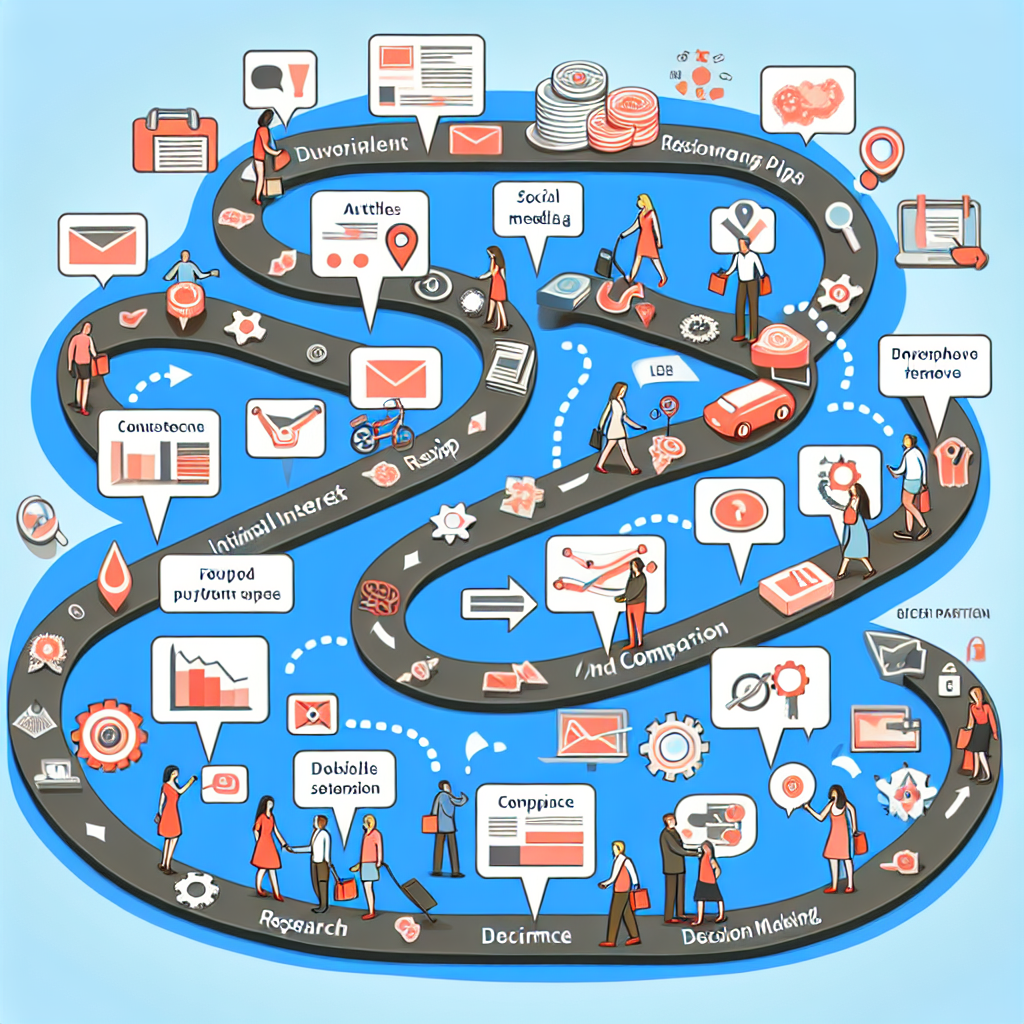Customer journey mapping for content marketing
Are you struggling to effectively engage with your target audience through your content marketing efforts? Look no further than customer journey mapping. Customer journey mapping provides valuable insights into the various touchpoints and interactions a customer has with your brand throughout their entire journey. By mapping out the customer’s experience, you can identify opportunities to create relevant and personalized content that resonates with your audience at every stage. In this article, we’ll explore the different stages of the customer journey and how customer journey mapping can enhance your content marketing strategy. Whether you’re new to customer journey mapping or looking to refine your approach, we’ve got you covered. Let’s dive in and unlock the key to creating impactful content that captivates your audience and drives results.
Customer journey mapping
Customer journey mapping is a valuable tool in content marketing that helps businesses understand and meet the needs of customers at every stage of their journey. It involves visualizing the steps a customer takes from initial awareness of a product or service to their final decision or purchase. By mapping out this journey, businesses can identify touchpoints and opportunities for engaging with customers, creating personalized content, and ultimately driving conversions and sales.
What is customer journey mapping?
Customer journey mapping is the process of creating a visual representation of the steps a customer takes during their interaction with a business. It helps businesses identify the different stages a customer goes through, the touchpoints they encounter, and the emotions they experience along the way. This tool allows businesses to gain a deeper understanding of their customers’ needs and preferences, and tailor their content marketing efforts to address these.
Why is customer journey mapping important for content marketing?
Customer journey mapping is essential for content marketing because it helps businesses align their content strategies with the needs and expectations of their target audience. By understanding the customer journey, businesses can create content that resonates with customers at each stage, providing them with the information and support they need. This results in more effective content, higher customer engagement, and ultimately, increased conversions and sales.

Benefits of customer journey mapping
There are several key benefits to customer journey mapping in content marketing:
-
Improved customer experience: By mapping out the customer journey, businesses can identify pain points and areas where customers may feel frustrated or confused. By addressing these issues, businesses can improve the overall customer experience and increase customer satisfaction.
-
Enhanced personalization: Customer journey mapping allows businesses to understand their customers’ preferences and needs at different stages of the journey. This knowledge enables businesses to create more personalized and targeted content, providing customers with the information and support they are looking for.
-
Increased customer engagement: Mapping the customer journey helps businesses identify touchpoints where they can engage with customers effectively. By providing relevant and valuable content at these touchpoints, businesses can capture the attention and interest of customers, leading to increased engagement and interaction.
-
Higher conversions and sales: Effective customer journey mapping enables businesses to create content that guides customers towards making a purchase or taking a desired action. By aligning content with the customer journey, businesses can nurture leads, build trust, and ultimately drive conversions and sales.
-
Better understanding of customer behavior: By analyzing the customer journey and tracking customer interactions, businesses can gain valuable insights into customer behavior and preferences. This data can inform content strategies, product development, and overall business decisions.
The customer journey mapping process
Customer journey mapping involves several key steps:
Defining the customer journey
The first step in customer journey mapping is to clearly define the different stages a customer goes through when interacting with a business. This typically includes stages such as awareness, consideration, purchase, and loyalty. By understanding these stages, businesses can map out the entire customer journey and identify key touchpoints.
Identifying customer touchpoints
Once the stages of the customer journey are defined, businesses need to identify the touchpoints that customers encounter throughout their journey. These touchpoints can be both online and offline, including social media, website visits, customer service interactions, and more. By identifying these touchpoints, businesses can ensure they are providing the right content and support at each stage.
Mapping the customer journey stages
The next step is to visually map out the customer journey, including the various touchpoints and channels that customers interact with. This can be done using flowcharts, diagrams, or other visual tools. By mapping the customer journey, businesses can gain a clear understanding of the overall flow and identify areas where improvements can be made.
Creating buyer personas
Buyer personas are fictional representations of a business’s ideal customers. They help businesses understand their target audience better and tailor their content marketing efforts accordingly. Creating accurate buyer personas is crucial for effective customer journey mapping.
What are buyer personas?
Buyer personas are detailed descriptions of the characteristics, goals, and pain points of a business’s target customers. They are created based on research, data analysis, and insights from existing customers. Buyer personas help businesses understand their customers’ needs, preferences, and motivations, allowing them to create targeted content that resonates with their audience.
How to create accurate buyer personas
To create accurate buyer personas, businesses should conduct thorough research and collect relevant data. This can include analyzing customer demographics, conducting surveys or interviews, and studying customer behavior and preferences. The goal is to gather insight into who the target audience is, what they value, and what challenges they face. This information is then used to create detailed profiles that represent different types of customers.
Using buyer personas in customer journey mapping
Buyer personas play a crucial role in the customer journey mapping process. They help businesses understand the different needs and preferences of their target audience at each stage of the journey. By aligning content with specific buyer personas, businesses can create content that is relevant and valuable to their ideal customers, increasing engagement and driving conversions.

Aligning content with the customer journey
Once the customer journey and buyer personas are defined, businesses can align their content strategies with the different stages of the journey. This involves creating content that resonates with customers at each stage and providing the right information and support.
Creating content for each stage of the customer journey
At the awareness stage, businesses should focus on creating content that grabs the attention of potential customers and introduces them to the brand or product. This can include educational blog posts, social media content, and videos.
At the consideration stage, businesses should provide more in-depth content that helps customers evaluate their options and make informed decisions. This can include product comparisons, case studies, and expert guides.
At the purchase stage, businesses should provide content that helps customers make the final decision and complete the purchase. This can include testimonials, product demonstrations, and limited-time offers.
At the loyalty stage, businesses should focus on providing content that nurtures customer relationships and encourages repeat purchases. This can include personalized emails, loyalty programs, and exclusive content.
Using customer insights to inform content creation
Customer insights, gathered through data analysis and customer feedback, are invaluable in informing content creation. By analyzing customer behavior and preferences, businesses can identify the types of content that resonate with their audience and create more of it. This ensures that content is relevant and valuable, increasing engagement and driving conversions.
Optimizing content for different touchpoints
Different touchpoints require different types of content. Businesses should optimize their content for specific touchpoints to ensure it is effective and delivers the intended message. For example, content on social media platforms should be concise, visually appealing, and shareable, while content on a website should be informative and easy to navigate.
Benefits of content marketing throughout the customer journey
Content marketing plays a crucial role in every stage of the customer journey, providing unique benefits at each stage.
Building brand awareness
At the awareness stage, content marketing helps businesses build brand awareness and attract potential customers. By creating valuable and shareable content, businesses can reach a wider audience and establish themselves as industry experts or thought leaders.
Attracting and engaging potential customers
Content marketing is an effective way to attract and engage potential customers. By providing useful and relevant content, businesses can capture the attention and interest of their target audience, encouraging them to learn more about the brand and its offerings.
Educating customers about products or services
Content marketing allows businesses to educate customers about their products or services. By creating informative and educational content, businesses can help customers understand the value and benefits of their offerings, building trust and credibility.
Driving conversions and sales
Content marketing plays a significant role in driving conversions and sales. By creating persuasive and compelling content, businesses can encourage potential customers to take the desired action, such as making a purchase or signing up for a service.
Nurturing customer loyalty and advocacy
Content marketing is vital for nurturing customer loyalty and advocacy. By consistently providing valuable and engaging content, businesses can keep existing customers satisfied and motivated to continue their relationship with the brand. Additionally, satisfied customers are more likely to recommend the brand to others, leading to increased advocacy and word-of-mouth marketing.
Measuring the effectiveness of content marketing
To determine the effectiveness of content marketing efforts, businesses need to measure key performance indicators (KPIs) and analyze customer behavior and engagement.
Defining key performance indicators (KPIs)
KPIs are measurable metrics that indicate the success of content marketing efforts. Examples of KPIs include website traffic, email open rates, social media engagement, and conversion rates. By setting specific KPIs and tracking them regularly, businesses can assess the impact of their content on the customer journey and make data-driven decisions.
Using analytics tools to track content performance
Analytics tools, such as Google Analytics, provide valuable insights into customer behavior and content performance. By tracking metrics such as page views, time on page, and bounce rates, businesses can gain a better understanding of how customers interact with their content and make necessary adjustments.
Analyzing customer behavior and engagement
Analyzing customer behavior and engagement involves studying how customers interact with content throughout the customer journey. By analyzing data such as click-through rates, social shares, and comments, businesses can gain insights into what content resonates with their audience and make informed decisions regarding content creation and distribution.
Understanding the impact of content on conversions
Content plays a crucial role in driving conversions, and businesses should analyze its impact on the sales funnel. By tracking how content contributes to lead generation, lead nurturing, and conversion rates, businesses can optimize their content marketing strategies to achieve higher conversion rates.
Optimizing the customer journey with content marketing
To optimize the customer journey, businesses should continually refine their content marketing strategies based on customer feedback and by identifying gaps and opportunities in the customer journey.
Identifying gaps and opportunities in the customer journey
By analyzing customer feedback and data, businesses can identify gaps and opportunities in the customer journey. For example, if customers express frustration during the purchase stage, businesses can create content or provide additional support to address these pain points, thus improving the overall customer experience.
Tailoring content to address customer pain points
Customer pain points are areas where customers face challenges or frustrations. By identifying these pain points and creating content specifically designed to address them, businesses can demonstrate their understanding of customer needs and build trust and loyalty.
Personalizing content to enhance the customer experience
Personalization is key to enhancing the customer experience. By tailoring content to individual customer preferences, businesses can create a more personalized and engaging experience. This can be achieved through strategies such as dynamic content, targeted emails, and personalized recommendations.
Testing and refining content based on customer feedback
Customer feedback is invaluable in refining and improving content marketing strategies. By actively seeking and analyzing customer feedback, businesses can identify areas for improvement and make necessary adjustments to content, ensuring it meets customer needs and expectations.
Integrating customer journey mapping with other marketing strategies
To maximize the effectiveness of customer journey mapping, businesses should integrate it with other marketing strategies, such as SEO, social media marketing, email marketing, and influencer collaborations.
Combining customer journey mapping with SEO
By aligning customer journey mapping with SEO strategies, businesses can ensure that their content is discoverable and relevant to customers at each stage of the journey. Keyword research, on-page optimization, and content creation should all be informed by customer journey insights.
Leveraging customer journey insights for social media marketing
Social media marketing can be enhanced by leveraging customer journey insights. By understanding where customers spend their time and what type of content resonates with them, businesses can create targeted social media campaigns that are tailored to each stage of the customer journey.
Integrating customer journey mapping with email marketing
Email marketing is an effective tool for nurturing leads and driving conversions. By aligning email campaigns with the customer journey, businesses can deliver personalized and timely content that guides customers through the different stages and encourages them to take action.
Enhancing customer journey through influencer collaborations
Influencer collaborations can significantly impact the customer journey. By partnering with influencers whose audience aligns with their target market, businesses can reach a wider audience and generate trust and credibility. Integrating influencer collaborations with customer journey mapping ensures that the content is aligned with the journey’s objectives and provides maximum impact.
Best practices for customer journey mapping in content marketing
To ensure successful customer journey mapping in content marketing, businesses should follow these best practices:
Researching and understanding your target audience
Thorough research and understanding of the target audience are essential for effective customer journey mapping. This includes analyzing demographics, conducting surveys or interviews, and studying customer behavior and preferences. The more businesses know about their target audience, the better they can create accurate buyer personas and map the customer journey.
Using data and analytics to inform customer journey mapping
Data and analytics provide valuable insights into customer behavior and preferences. By utilizing data from analytics tools, businesses can understand how customers interact with their content and identify opportunities for improvement. By leveraging this data, businesses can make informed decisions when mapping the customer journey and creating targeted content.
Collaborating with cross-functional teams
Successful customer journey mapping requires collaboration across various departments and teams within a business. By involving stakeholders from marketing, sales, customer service, and product development, businesses can gain different perspectives and expertise, resulting in a more comprehensive and effective customer journey map.
Continuously iterating and improving the customer journey
Customer journeys are not static and evolve over time. It is crucial for businesses to continuously monitor and evaluate the effectiveness of their customer journey maps and make necessary adjustments. By seeking customer feedback, tracking KPIs, and staying up-to-date with industry trends, businesses can optimize the customer journey and ensure that their content marketing efforts remain relevant and impactful.
Conclusion
Customer journey mapping is a valuable tool in content marketing that helps businesses craft effective strategies to meet the needs and expectations of their customers. By understanding the different stages of the customer journey, mapping touchpoints, and creating personalized and targeted content, businesses can enhance the overall customer experience, drive conversions and sales, and build lasting customer loyalty. By integrating customer journey mapping with other marketing strategies and regularly measuring and optimizing content performance, businesses can continuously refine their approach and improve their content marketing efforts. With the right insights and strategies, businesses can create a seamless and engaging customer journey that leads to long-term success.

















It's great that you talked about how business insurance can provide financial protection against unexpected events and help ensure the…
I like that you mentioned how business insurance is essential for protecting your bottom line and the long-term viability of…